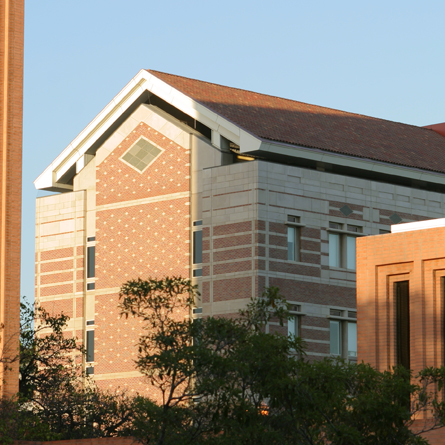Survivors of the Shoah Visual History Foundation Becomes a Part of the University of Southern California
Fri, 09/16/2005 - 12:00am

 The Institute's home at Leavey Library on the main campus of USC
The Institute's home at Leavey Library on the main campus of USCUnder the arrangement, the Shoah Foundation’s repository of 52,000 testimonies of survivors and other witnesses to the Holocaust will be transferred to USC in perpetuity. In addition, the new USC Shoah Foundation Institute for Visual History and Education will be dedicated to research and scholarship in the humanities and social sciences.
“We are very pleased to welcome the Shoah Foundation as part of USC,” said USC President Steven B. Sample. “It is a significant addition to our strengths in the humanities and social sciences, and the Foundation’s pre-eminent collection of Holocaust materials will advance academic research and scholarship for centuries as we continue to honor the memory of Holocaust victims and survivors.”
Douglas Greenberg , Shoah Foundation president and CEO, said, “The alliance between the Shoah Foundation and USC is a natural one and promises to make the resources of the Shoah Foundation available to an ever growing public inside and outside the academic world.
“The testimonies in the Foundation’s archive are essential primary sources for scholarship and education about the Shoah. Like all such collections, their effective use depends upon a community of researchers and teachers prepared to exploit them to advance research and education.
“As one of the great American research universities, USC provides just such a community, as well as the technological expertise to support the archive and its use. In addition, USC has a deep commitment to internationalizing its work, and the Shoah Foundation’s archive is a quintessentially international resource collected in 56 countries and in 32 languages.”
Steven Spielberg, Shoah Foundation Founding Chairman and a USC Trustee, added: “I am delighted that USC will provide a permanent repository for the Foundation’s 52,000 testimonies of survivors and other witnesses to the Holocaust. Preservation of these priceless interviews is the Shoah Foundation’s highest priority, and our move to USC ensures both preservation and access. All of us know that the survivors and witnesses have given us a precious gift whose wise use will build a better world for this and future generations. That knowledge will guide all we do in the future just as it has in the past.”
USC has been a leader in the development of digital libraries, and its Thomas and Dorothy Leavey Library provides state-of-the-art technological resources for preserving these archival materials and for providing access for researchers and scholars from around the world.
“The Shoah Foundation’s collection is the largest digital library in the world, and its presence at USC will greatly enhance our scholarship in the humanities and social sciences,” said USC Provost C. L. Max Nikias.
“As scholars, we see this arrangement as an exceptional opportunity to simultaneously enhance both the resources of the Shoah Foundation and of the University of Southern California. We look forward to leveraging our common expertise in digital library management to provide global access for scholars to these important archives.”
Added USC College Dean Joseph Aoun: “These profound visual testimonies have a tremendous educational purpose for this generation and future generations who must learn about the atrocity of the Holocaust and genocide. The new USC Shoah Foundation Institute will position us as the leader in the study of visual history, an increasingly important medium for humanity to record its past.”
The Shoah Foundation testimonies, nearly 52,000 from Holocaust survivors and other witnesses, comprise the largest visual history archive in the world. The Foundation’s mission is to overcome prejudice, intolerance, and bigotry—and the suffering they cause—through the educational use of its visual history testimonies. The organization relies on global partnerships to achieve three strategic goals: to preserve and provide access to the archive; to build and support educational programs; and to develop educational products based on the Foundation’s testimonies. Shoah Foundation educational programs and products are currently reaching nearly two million students in the United States and around the world. Currently, 44 Visual History Collections can be viewed at locations in 16 countries.
Like this article? Get our e-newsletter.
Be the first to learn about new articles and personal stories like the one you've just read.